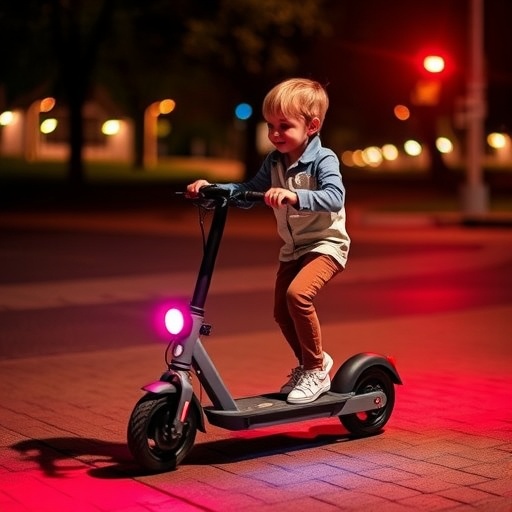In recent years, electric scooters have surged in popularity, particularly among younger generations seeking a fun and efficient mode of transportation. However, this rise in use has been accompanied by a troubling increase in injuries, sparking a wave of concern among health professionals. A recently published study by Abu-Kishk et al. reveals critical insights into the dangers that electric scooters pose to children, which could serve as a wake-up call for parents, healthcare providers, and policymakers alike.
The study, titled “Electric scooter related injuries among children: a single institutional experience,” sheds light on the alarming rate at which injuries are occurring. The research takes a closer look at the impacts of electric scooter use among a vulnerable demographic. It meticulously documents various injuries sustained, their severity, and the common circumstances that lead to these accidents. Given the nature of electric scooters, which are generally perceived as safe and simple to use, the findings of this study raise significant concerns about their safety for children.
In examining the medical records of pediatric patients treated for electric scooter-related injuries, the researchers found a disturbing trend that cannot be overlooked. The majority of injuries were documented as occurring in children who were either novice users or unsupervised while riding. This points to a crucial gap in safety measures, suggesting that many children may be unsuited to navigate the responsibilities that come with using such devices. In addition to the physical injuries documented, the emotional and psychological ramifications of scooter incidents must also be considered, particularly among minor users who may face trauma following a serious accident.
The mechanics of electric scooters themselves deserve scrutiny within this context. Most electric scooters operate at relatively high speeds, often exceeding 15 mph, which can be hazardous for inexperienced riders. These speeds may result in high-impact collisions when accidents occur, leading to serious injuries such as fractures, concussions, and soft tissue damage. The fact that children do not have the same level of coordination or decision-making skills as adults increases their risk of severe injuries considerably when riding adult-sized scooters.
An interesting finding from the study is the demographics of the injured children. The data revealed that boys accounted for a higher percentage of injuries compared to girls. This statistic could indicate that boys are more likely to engage in risk-taking behaviors or that they are more frequently allowed or encouraged to ride electric scooters without adequate safety measures in place. Understanding the factors that contribute to this disparity will be essential for developing targeted safety interventions.
Another significant aspect of the research is the role of protective gear. Surprisingly, the study found that a minimal percentage of injured children were wearing helmets or other protective gear at the time of their accidents. This glaring oversight highlights the need for increased awareness about the importance of safety equipment when riding electric scooters. Helmets can dramatically reduce the severity of head injuries, and promoting their use among children could play an essential role in preventing severe injuries.
The findings of the study also raise questions about the responsibility of electric scooter manufacturers and rental companies. With the rapid proliferation of electric scooters in urban areas, there is a moral imperative for companies to provide clearer safety guidelines and age restrictions. Enhanced safety protocols that ensure proper education and equipment for riders could mitigate potential injuries significantly. Regulatory measures are also necessary to ensure that safety is prioritized over profit.
Public awareness campaigns and educational initiatives targeted at parents and children can serve as important tools in promoting safe riding practices. By incorporating discussions about the risks of electric scooters into school curricula, children can be better informed about how to ride safely. Engaging parents in these discussions can also help foster a culture of safety both at home and in the community.
Moreover, future research should delve deeper into the long-term implications of electric scooter accidents among children. What are the psychological effects of being involved in scooter injuries? How do these incidents impact their willingness to ride scooters again? Understanding the full scope of these outcomes can guide both clinical practices and educational efforts moving forward.
In conclusion, while electric scooters may represent a modern mode of transportation that appeals to youth, the inherent risks associated with their use cannot be ignored. The study conducted by Abu-Kishk et al. serves to illuminate these concerns, offering a call to action for stakeholders involved in child safety. By addressing these issues through improved safety measures, public education, and responsible corporate practices, we can work towards ensuring that electric scooters remain a fun and safe way for children to explore their environments.
Understanding the dynamics of the injuries identified in this recent study can help shape the frameworks for policy adjustments necessary to protect our most vulnerable users. It is crucial that parents, educators, and regulators collaborate to establish a safer environment for electric scooter use, ensuring that these vehicles can be enjoyed without undue risk. As more children embrace this mode of transport, we must remain vigilant in our efforts to prioritize their safety and well-being.
As the landscape of transportation continues to evolve, so too must our strategies for safeguarding children. Through informed discourse and comprehensive safety protocols, we can ensure that electric scooters contribute positively to their mobility experiences while minimizing the risk of injury.
Subject of Research: Electric scooter-related injuries in children.
Article Title: Electric scooter related injuries among children: a single institutional experience.
Article References:
Abu-Kishk, A., Kozer, E., Berkowiz, R.B. et al. Electric scooter related injuries among children: a single institutional experience.
BMC Pediatr 25, 787 (2025). https://doi.org/10.1186/s12887-025-06181-8
Image Credits: AI Generated
DOI:
Keywords: Electric scooters, children, injuries, safety, protective gear, public health.
Tags: child electric scooter injurieschild transportation safetyelectric scooter accident statisticselectric scooter safety concernselectric scooter usage trends among youthhealth risks of electric scootershealthcare implications of scooter injuriesimproving child safety on electric scootersparental awareness of scooter dangerspediatric injuries from scooterssafety regulations for electric scootersscooter-related injuries in children





